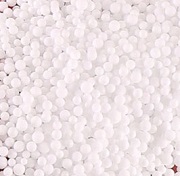Ammonium sulphate is an important nitrogen and sulphur fertilizer with a global output of over 30 million metric tonnes per year (or over 6 million metric tonnes by nitrogen content). As major contributors of soil nitrogen for synthetic N fertilization, such fertilizers as urea or ammonium nitrate significantly surpass ammonium sulphate, which is reflected in their much larger production volumes. However, ammonium sulphate application as a source of sulphur has become quintessential for the purposes of well-balanced plant nutrition, particularly with specific soils, plants, tillage practices, and application conditions (e.g., soils with sulphur deficit). Moreover, ammonium sulphate could be readily obtained as a by-product of various industrial processes (e.g., caprolactam or methyl methacrylate production), and it is cheaper as compared to many other fertilizer types. Apart from fertilization, ammonium sulphate applications include manufacturing food, pharmaceuticals, wood, and paper, as well as water treatment.
The steady dynamics of ammonium sulphate production growth over several decades confirms consistent global demand for this fertilizer despite the turbulent macroeconomic environment, agricultural policies, demand/supply fluctuations, seasonality factors, weather conditions, import/export regulations, and force majeure circumstances. Nevertheless, sustainability issues remain paramount in the light of severe degradation of soil, air, and water resources due to the violation of the N cycle and overfertilization. In general, extensive production, transportation, storage, and use of chemical fertilizers can be detrimental to the environment and humans, including such consequences as depleting soil nutrients, eutrophication, biodiversity loss, and increased carbon footprint. These externalities act as a powerful barrier against fertilizer use, which is reflected in the existence of strict pro-environmental laws and regulations. However, the necessity to boost fertilizer application is driven by the need to maintain high crop yields to support current demographic trends and consumerist lifestyles.
The previous year was turbulent for the sector of nitrogen fertilizers, which was largely driven by high natural gas and energy prices. To illustrate the point, one can mention the intricate situation at Unigel, one of the leaders in the nitrogen fertiliser market in Latin America. The company was adversely impacted by the combination of lower selling prices and high operational costs.
Ammonium sulphate: structure of the global production capacity by country, 2023

The US ammonium sulphate market behaved better than the markets for this fertilizer in other regions (the US remains a key manufacturer of ammonium sulphate in the world). Despite this fact, AdvanSix, which is one of the world’s largest producers of ammonium sulphate, recorded a significant drop in ammonium sulphate sales as compared to 2022. The company expects that the favourable agricultural season of 2024 and strong fundamentals of demand for ammonium sulphate could improve ammonium sulphate market behaviour this year, but H1 2024 is likely to be characterised by lower nitrogen pricing.
Find a detailed analysis of the ammonium sulphate market in the in-demand research report “Ammonium Sulphate: 2024 World Market Outlook and Forecast up to 2033”.
